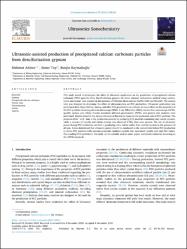| dc.contributor.author | Altiner, Mahmut | |
| dc.contributor.author | Top, Soner | |
| dc.contributor.author | Kaymakoglu, Burcin | |
| dc.date.accessioned | 2022-02-27T10:06:48Z | |
| dc.date.available | 2022-02-27T10:06:48Z | |
| dc.date.issued | 2021 | en_US |
| dc.identifier.issn | 1350-4177 | |
| dc.identifier.issn | 1873-2828 | |
| dc.identifier.other | PubMed ID33387759 | |
| dc.identifier.uri | https //doi.org/10.1016/j.ultsonch.2020.105421 | |
| dc.identifier.uri | https://hdl.handle.net/20.500.12573/1193 | |
| dc.description | This study was supported by the Scientific and Technological Research Council of Turkey (TUBITAK) [Project No: 119M134] . The authors would like to thank anonymous reviewers for their valuable comments. Also, the authors would like to thank Enago for the English review. | en_US |
| dc.description.abstract | This study aimed to investigate the effect of ultrasonic application on the production of precipitated calcium carbonate (PCC) particles from desulfurization gypsum via direct mineral carbonation method using conventional and venturi tube reactors in the presence of different alkali sources (NaOH, KOH and NH4OH). The venturi tube was designed to determine the effect of ultrasonication on PCC production. Ultrasonic application was performed three times (before, during, and after PCC production) to evaluate its exact effect on the properties of the PCC particles. Scanning electron microscope (SEM), X-ray diffraction (XRD), Atomic force microscope (AFM), specific surface area (SSA), Fourier transform infrared spectrometry (FTIR), and particle size analyses were performed. Results revealed the strong influence of the reactor types on the nucleation rate of PCC particles. The presence of Na+ or K+ ions in the production resulted in producing PCC particles containing only calcite crystals, while a mixture of vaterite and calcite crystals was observed if NH4+ ions were present. The use of ultrasonic power during PCC production resulted in producing cubic calcite rather than vaterite crystals in the presence of all ions. It was determined that ultrasonic power should be conducted in the venturi tube before PCC production to obtain PCC particles with superior properties (uniform particle size, nanosized crystals, and high SSA value). The resulting PCC particles in this study can be suitably used in paint, paper, and plastic industries according to the ASTM standards. | en_US |
| dc.description.sponsorship | Turkiye Bilimsel ve Teknolojik Arastirma Kurumu (TUBITAK) 119M134 | en_US |
| dc.language.iso | eng | en_US |
| dc.publisher | ELSEVIERRADARWEG 29, 1043 NX AMSTERDAM, NETHERLANDS | en_US |
| dc.relation.isversionof | 10.1016/j.ultsonch.2020.105421 | en_US |
| dc.rights | info:eu-repo/semantics/openAccess | en_US |
| dc.subject | Gypsum | en_US |
| dc.subject | Precipitated calcium carbonate | en_US |
| dc.subject | Venturi tube | en_US |
| dc.subject | Ultrasonication | en_US |
| dc.subject | Calcite | en_US |
| dc.subject | Vaterite | en_US |
| dc.title | Ultrasonic-assisted production of precipitated calcium carbonate particles from desulfurization gypsum | en_US |
| dc.type | article | en_US |
| dc.contributor.department | AGÜ, Mühendislik Fakültesi, Malzeme Bilimi ve Nanoteknoloji Mühendisliği Bölümü | en_US |
| dc.contributor.authorID | 0000-0003-3486-4184 | en_US |
| dc.contributor.institutionauthor | Top, Soner | |
| dc.identifier.volume | Volume 72 | en_US |
| dc.relation.journal | ULTRASONICS SONOCHEMISTRY | en_US |
| dc.relation.tubitak | 119M134 | |
| dc.relation.publicationcategory | Makale - Uluslararası - Editör Denetimli Dergi | en_US |


















